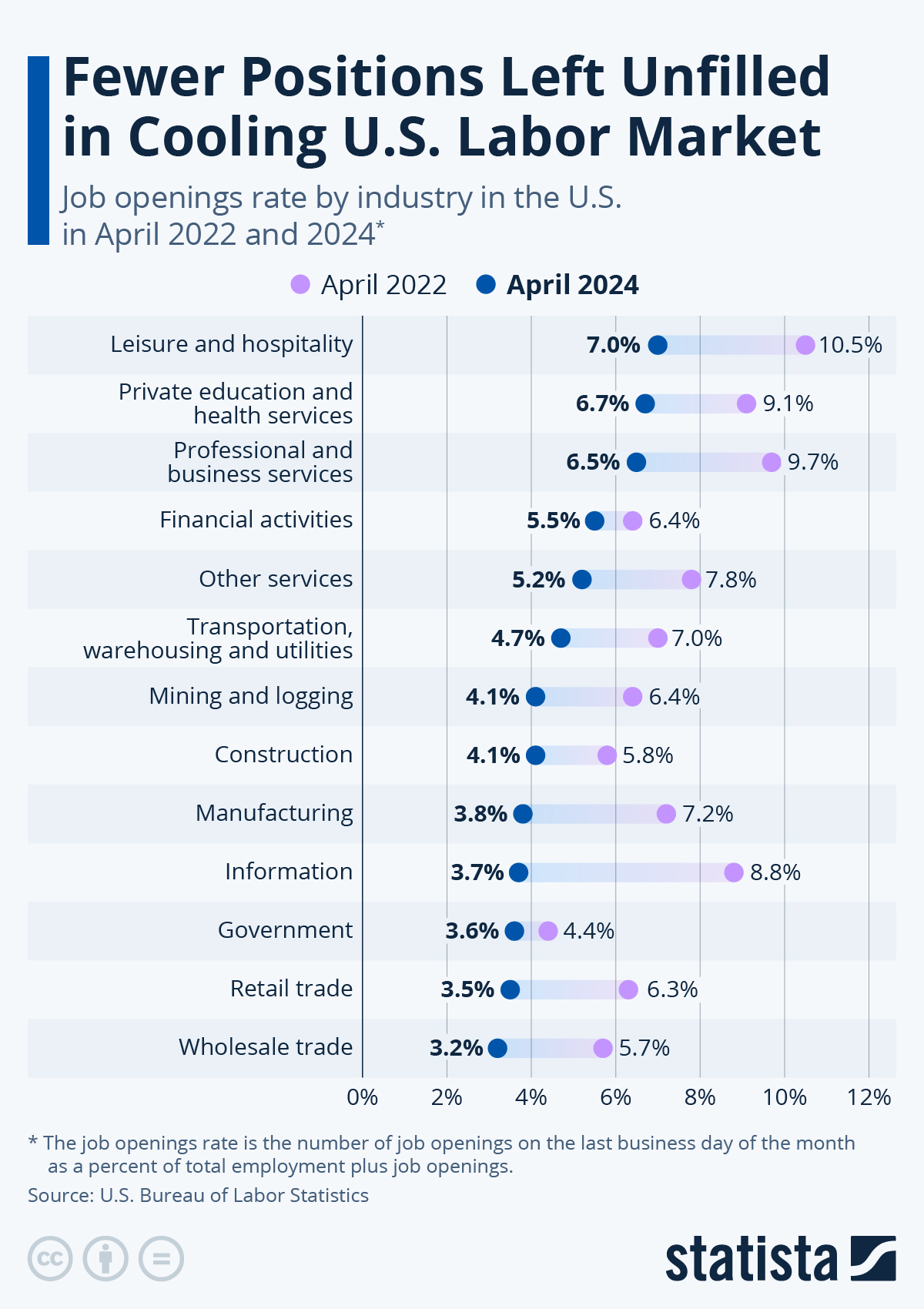The recent staffing issues experienced by our industry aren’t so recent if we are being honest with ourselves. They predate the pandemic and have always provided consternation to operators across the spectrum in hospitality. But the disruptions caused by the COVID-19 pandemic have shown in stark relief just how vulnerable our staffing circumstance was to start.
A September survey, by the Bureau of Labor Statistics (BLS), reflects how acute that vulnerability has become. At 9.4% underemployment, we lead the pack.
We’re Number One… Sadly
 You will find more infographics at Statista
You will find more infographics at Statista
If you want further context, the most analogous business on the list is Retail whose underemployment is nearly 28% less than ours at just 6.8%. This means the mall, corner store, or big box stores are all having an easier time finding staff in the wake of the pandemic. The fact that we can’t compete for the candidates those folks seek is a sure sign that we have a significant problem that needs our immediate attention.
There are solutions, but they mostly require a true shift in paradigm or, worse, will force you to raise your expenses to accommodate them. Here are three ideas you can implement to improve your staffing. While they won’t sound palatable, they might be your only way out of this mess.
1. Make Your Restaurant a Better Place to Work
This might sound obvious, but you’d be surprised how few operators focus on the culture of their restaurants. There are myriad ways to accomplish this -- some will cost you money and others will only cost you your time, attention and some empathy.
For example, create a two-way communication system for your employees. Let them have a voice in the way you approach managing them. This doesn’t mean you are giving the keys to inmates, but it will clearly help them feel more engaged with your business and less likely to leave.
The turnover caused by not addressing your culture is a certain financial incentive to make changes. We know that hiring a new employee will cost you over $5,000 for the whole process from recruiting to fully functioning staff member. What if you retained that employee by providing health insurance, that might only cost you $1,000 per year? Certainly, if I offered you a guaranteed savings of $5k by spending $1k, you’d take that trade all day long.
This may sound simplistic, but, honestly, the solution itself is pretty simple. The more you do spend with the intention of retaining staff is returned in kind by the retention itself. Whether it’s staff scheduling software or adding paid time off to your benefits, for every employee you retain, your costs drop commensurately. Any focus on improving your company culture is sure fire way to save you money through the improved retention is creates.
2. Ditch the Tip
Here we are going to again make the argument that it’s time to ditch the tipping model. While the service minimum wage plays a roll in why tipping is attractive to operators, the true effect of the concept means we are asking the guest to pay a premium for service. They pay it directly to the server which alone causes significant stress in our industry and is a valid reason of its own to move on from the tipping approach.
But you can still require a service charge in which control how that money is apportioned. Let’s say you do $10,000 in sales for the day, depending on your service charge amount it will capture between $1,800 and $2,000 in revenue. If you apply this directly to your overall labor expense, you can accommodate the increases in payroll that will accompany ending the tipping paradigm. In fact, servers paid a living wage that is guaranteed are more likely to stay with you in the long term. This way you can also pay your full team more money with that revenue. It’s treating your staff like professionals and not a summer tempt gig.
We need to face the truth that no one wants to work in a place that feels dangerous and that doesn’t pay a living wage. You’ll be surprised when you institute a no-tip paradigm that servers knowing how much they will earn will perform just as well as those that were incentivized by a gratuity.
3. Let Technology Set You Free
If we have learned anything from the pandemic, it is the role that technology can play in improving our efficiency. COVID-19 has forcibly vaulted our industry into the 21st Century when it comes to technology. From pay at the table to online ordering, operators have been compelled to embrace approaches to the service cycle that would have been considered unthinkable in February of 2020. This is a very good thing for the industry, and will only serve to improve your operations going forward.
The best example we have seen is order-at-the-table systems that allow a guest to place an order prior to interacting with a server. This may sound counter intuitive, but if a guest orders their beverages as soon as they are seated, the first visit from the service can include the delivery of that drink order. This significantly improves the first service experience the guest has by dramatically reducing the time it takes for their drinks to arrive.
The other horrible guest experience invariably surrounds paying their guest check. Here again, the guest can access their bill, process and pay whenever they are ready. This transaction is normally among the most frustrating a guest can endure, however pay-at-the-table ends that and reduces dwell times allowing you to seat more parties in a shorter period. This is a win for everyone from the guest to the server…oh and it also will reduce your labor cost by allowing a server to care for more tables, see everybody wins.
What are You Waiting for?
We are convinced that being understaffed is a choice not to respond to the circumstances of the moment. The strategies are not novel, but they are a path to rid yourself of the troubles being caused by your dearth of staff. By making your place a better environment, creating equity in pay across your entire operation and embracing technology, you are doing the most basic things to climb out of the hole. From there it will require you maintain these approaches because the new normal demands it.














